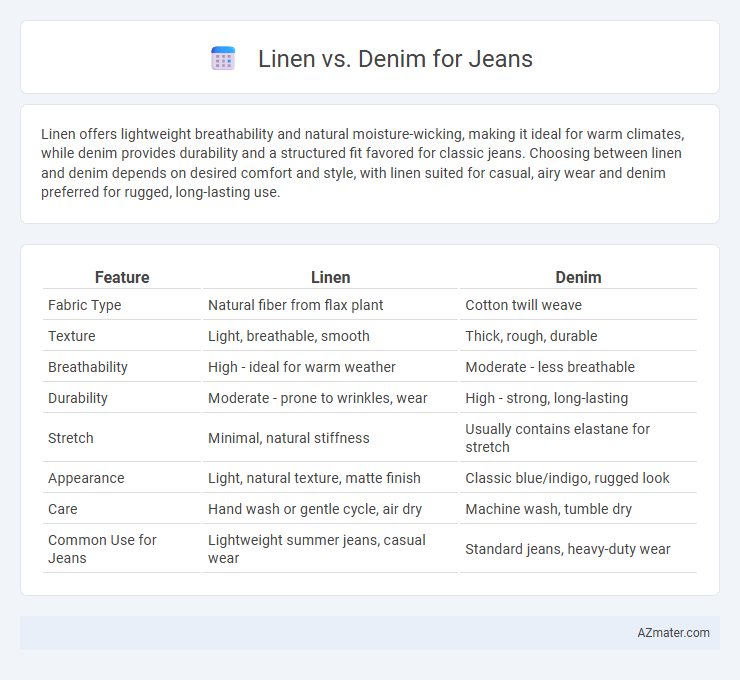Linen offers lightweight breathability and natural moisture-wicking, making it ideal for warm climates, while denim provides durability and a structured fit favored for classic jeans. Choosing between linen and denim depends on desired comfort and style, with linen suited for casual, airy wear and denim preferred for rugged, long-lasting use.
Table of Comparison
| Feature | Linen | Denim |
|---|---|---|
| Fabric Type | Natural fiber from flax plant | Cotton twill weave |
| Texture | Light, breathable, smooth | Thick, rough, durable |
| Breathability | High - ideal for warm weather | Moderate - less breathable |
| Durability | Moderate - prone to wrinkles, wear | High - strong, long-lasting |
| Stretch | Minimal, natural stiffness | Usually contains elastane for stretch |
| Appearance | Light, natural texture, matte finish | Classic blue/indigo, rugged look |
| Care | Hand wash or gentle cycle, air dry | Machine wash, tumble dry |
| Common Use for Jeans | Lightweight summer jeans, casual wear | Standard jeans, heavy-duty wear |
Introduction to Linen and Denim Jeans
Linen jeans are crafted from flax fibers, offering breathability, lightweight comfort, and a natural texture ideal for warm weather. Denim jeans, traditionally made from sturdy cotton twill, provide durability, a distinctive weave, and versatility that suits various styles and seasons. Both fabrics have unique qualities, with linen emphasizing softness and airflow, while denim guarantees rugged strength and timeless appeal.
Fabric Origins and Composition
Linen is derived from the flax plant fibers, prized for its natural breathability and lightweight texture, making it ideal for summer jeans. Denim originates from cotton fibers woven in a twill pattern, providing durability and a rugged structure commonly associated with classic jeans. Both fabrics offer unique compositions: linen's cellulose-based fibers contrast with cotton's softer, more flexible properties in denim.
Comfort and Breathability Comparison
Linen offers superior breathability and moisture-wicking properties compared to denim, making linen jeans ideal for hot and humid climates. Denim, typically made from heavier cotton twill, provides more durability but can trap heat and feel less comfortable during extended wear in warm weather. For maximum comfort and airflow, linen is the preferred fabric, while denim remains better suited for cooler temperatures and rugged use.
Durability and Longevity
Denim jeans are renowned for their exceptional durability, crafted from tightly woven cotton twill that withstands heavy wear and frequent washing without significant degradation. Linen jeans, while breathable and comfortable, generally lack the same longevity due to linen's natural fiber composition, which is more prone to wear and tear over time. For long-lasting jeans designed to endure rigorous use, denim remains the superior choice because of its resilience and robust fabric structure.
Style and Versatility
Linen jeans offer a lightweight, breathable fabric ideal for warm weather, featuring a relaxed, casual style that effortlessly complements summer wardrobes. Denim jeans provide structured durability with a classic, versatile silhouette suitable for both casual and semi-formal settings, making them a timeless staple. Linen's natural texture contrasts with denim's rugged feel, allowing for diverse styling options across different seasons and occasions.
Seasonal Suitability: Linen vs Denim
Linen jeans excel in warm-weather seasons due to their lightweight, breathable fabric that promotes airflow and moisture-wicking, keeping the wearer cool and comfortable. Denim jeans are better suited for cooler seasons, offering thicker, insulating material that provides warmth and durability. Choosing between linen and denim for jeans depends largely on the climate, with linen ideal for spring and summer and denim preferred in fall and winter.
Care and Maintenance Needs
Linen jeans require gentle washing in cold water and air drying to prevent fabric shrinkage and maintain breathability, while denim jeans can withstand more frequent washing, often in warm water, to preserve their shape and color. Avoid bleach and harsh detergents for both fabrics, but linen benefits from ironing at medium heat to reduce wrinkles, whereas denim tends to soften with wear and needs minimal pressing. Proper storage involves hanging linen jeans to avoid creases, and folding denim to maintain its structure and prevent stretching.
Environmental Impact of Fabrics
Linen, derived from flax plants, has a significantly lower environmental impact compared to denim, as it requires less water, fewer pesticides, and produces less carbon emissions during cultivation and processing. Denim, primarily made from cotton, demands intensive water usage and contributes to soil degradation and high energy consumption in dyeing and finishing processes. Choosing linen jeans supports sustainable fashion by reducing resource depletion and minimizing pollution associated with traditional denim manufacturing.
Cost and Accessibility
Linen jeans generally cost more than denim due to the premium quality and labor-intensive weaving process of flax fibers. Denim is widely accessible and available in various price ranges, making it a more budget-friendly option for most consumers. Linen's limited production and niche market contribute to its higher price and less widespread availability compared to denim.
Choosing the Right Fabric for Your Jeans
Linen offers breathability and lightweight comfort, making it ideal for warm weather jeans, while denim provides durability and a structured fit suitable for everyday wear and rugged activities. Choosing between linen and denim depends on the desired combination of comfort, breathability, and longevity in your jeans. Consider linen for casual, breathable styles and denim for classic, long-lasting denim jeans.

Infographic: Linen vs Denim for Jean
 azmater.com
azmater.com